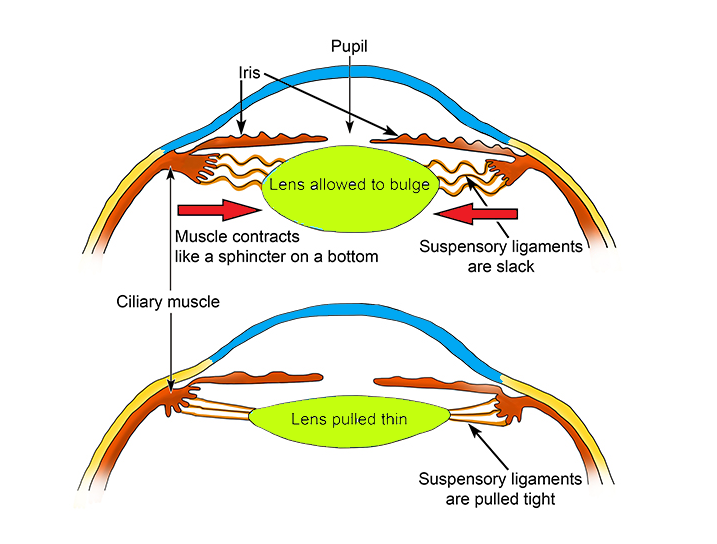
In the mammalian eye, the power of accommodation is controlled by changing the shape of the lens. It is governed by
A. Cornea
B. Pupil
C. Iris
D. Ciliary body
Answer
492.3k+ views
Hint: The power of accommodation is the ability of the eye, to readjust or change its focal length to view near or distant objects. This is done by changing the shape of the lens by the ciliary muscles. The ciliary muscles are a group of smooth muscle cells that are present in the middle/vascular layer of the eye.
Step by step answer:The mammalian eye is a complex structure that has several capabilities, one being the power of accommodation. The ability to accommodate the focal length of the lens to see objects placed near or far is called the power of accommodation.
This is done using the ciliary body. The ciliary body is a group of smooth muscles that are capable of changing the shape of the lens present within the eye. Changing the shape of the lens by shrinking or expanding results in an appropriate change in the focal length of the lens.

By doing so, it becomes easier to view objects placed at different distances from the eye. The ciliary muscles are controlled by the ciliary nerves. This is present in the middle layer of the eye or at the vascular layer of the eye.
Therefore, the correct option is D
Note: The ciliary muscles are responsible for changing the shape of the lens. By doing so objects at different distances can be focused clearly. The ability to focus on objects at a different distance is known as the power of accommodation. The main function of the cornea is for the protection of the eye and is not connected to the inner parts of the eye.
The pupil is the aperture of the eye, through which light enters and falls on the retina. The pupil is controlled by the iris which is also a group of smooth muscles that regulate the dilation of the pupil.
The changing of the size of the pupil is controlled by the pupillae muscles of the iris and changing the shape of the lens is by ciliary muscles.
Step by step answer:The mammalian eye is a complex structure that has several capabilities, one being the power of accommodation. The ability to accommodate the focal length of the lens to see objects placed near or far is called the power of accommodation.
This is done using the ciliary body. The ciliary body is a group of smooth muscles that are capable of changing the shape of the lens present within the eye. Changing the shape of the lens by shrinking or expanding results in an appropriate change in the focal length of the lens.

By doing so, it becomes easier to view objects placed at different distances from the eye. The ciliary muscles are controlled by the ciliary nerves. This is present in the middle layer of the eye or at the vascular layer of the eye.
Therefore, the correct option is D
Note: The ciliary muscles are responsible for changing the shape of the lens. By doing so objects at different distances can be focused clearly. The ability to focus on objects at a different distance is known as the power of accommodation. The main function of the cornea is for the protection of the eye and is not connected to the inner parts of the eye.
The pupil is the aperture of the eye, through which light enters and falls on the retina. The pupil is controlled by the iris which is also a group of smooth muscles that regulate the dilation of the pupil.
The changing of the size of the pupil is controlled by the pupillae muscles of the iris and changing the shape of the lens is by ciliary muscles.
Recently Updated Pages
Master Class 11 Economics: Engaging Questions & Answers for Success

Master Class 11 Business Studies: Engaging Questions & Answers for Success

Master Class 11 Accountancy: Engaging Questions & Answers for Success

Master Class 11 English: Engaging Questions & Answers for Success

Master Class 11 Computer Science: Engaging Questions & Answers for Success

Master Class 11 Maths: Engaging Questions & Answers for Success

Trending doubts
State and prove Bernoullis theorem class 11 physics CBSE

1 ton equals to A 100 kg B 1000 kg C 10 kg D 10000 class 11 physics CBSE

State the laws of reflection of light

One Metric ton is equal to kg A 10000 B 1000 C 100 class 11 physics CBSE

1 Quintal is equal to a 110 kg b 10 kg c 100kg d 1000 class 11 physics CBSE

Difference Between Prokaryotic Cells and Eukaryotic Cells




